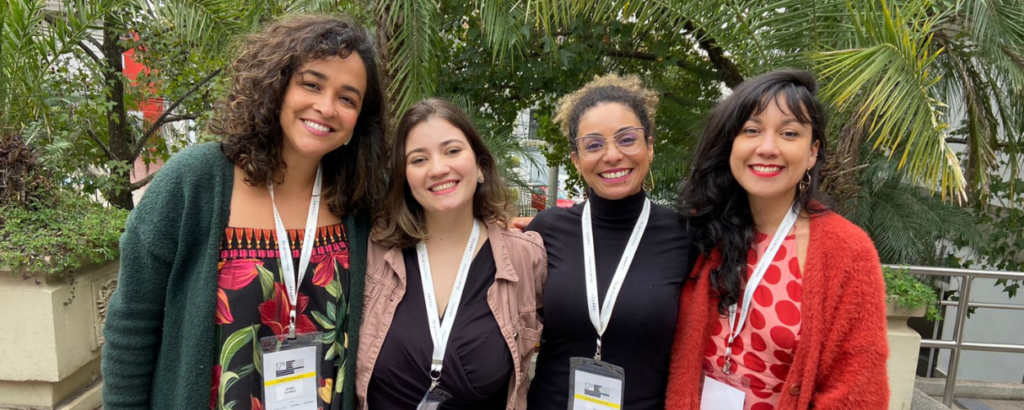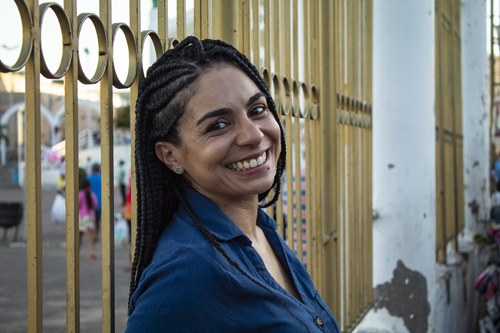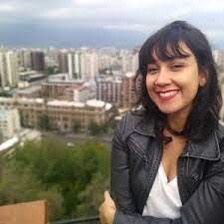Journalists Mariama Correia and Nayara Felizardo are half of the founding quartet of Cajueira, an initiative launched in 2020 as a newsletter curating journalistic content produced by independent media outlets in Northeast Brazil. With fellow journalists Joana Suarez and Mariana Ceci, they created Cajueira to strengthen independent journalism in the Northeast and combat prejudices about the region.
The Northeast is historically portrayed by media outlets based in the Southeast Brazil, especially on the Rio de Janeiro – São Paulo axis, as a place punished by drought and poverty. This representation reduces to stereotypes the region that contains the largest number of states (nine) and the second largest part of the country's population (27%, or 54.6 million people). Almost a third (31%) of Indigenous Brazilians live in the Northeast, and 73% of the region's population is Black, according to the 2022 Census.
According to Atlas da Notícia, the Northeast has 2,745 active journalistic outlets – or 19% of the active outlets mapped in the country – and 1,300 of them are digital outlets, like Cajueira itself.

Joana Suarez, Jayanne Rodrigues, Nayara Felizardo e Mariama Correia, part of the Cajueira team. (Photo: Courtesy)
In 2023, what is now called Rede Cajueira launched several products: a map of independent journalism in the Northeast, a bank of journalists and a bank of sources, and a platform that brings together all these initiatives, plus the newsletter and Cajuzap, an audio bulletin sent via WhatsApp. The website is also a showcase of journalism produced in the nine states, republishing articles produced by media outlets in the Northeast and selected by journalists from Cajueira.
Correia and Felizardo spoke with LatAm Journalism Review (LJR) about what has changed – and what has not – in journalistic coverage from within and outside the region, the strength of independent journalism carried out in the Northeast and Cajueira's next steps.
“We have managed to greatly strengthen independent journalism in the Northeast, and not just from Cajueira,” Felizardo said. “Cajueira contributes to this, but the media outlets are stronger and are even pushing for this change, this discussion about the importance of certain coverage without the bias that the Northeast is just drought and poverty. There are many more topics in this region.”
In addition to being co-founders of Cajueira, Mariama Correia is an editor and reporter at Agência Pública and Nayara Felizardo is a reporter at Intercept Brasil.
The journalists who work at Cajueira do so voluntarily for the production of the newsletter and Cajuzap. The platform that was launched in 2023, with a bank of sources and journalists, was developed with the support of the digital business acceleration program of the International Center for Journalists (ICFJ) and Meta (formerly Facebook), in addition to institutional support from the Digital Journalism Association (Ajor).
Below, read the interview with Correia and Felizardo, which has been edited for clarity and brevity.
1. One of Cajueira’s focuses is to combat “prejudices and the reproduction of stereotypes about the Northeast.” Do you think that there has been a change in [mainstream] coverage about the Northeast that you grew up seeing in television or print journalism and the coverage that is done today by these same media outlets?
Mariama Correia: In my memory, which is the memory of a person who was a child in the 1990s, I think very little has changed. I feel that, in the last ten or five years, we have evolved into many debates regarding various issues, such as feminist debates, gender debates, LGBTQIA+ rights, religious minorities, ethnic minorities, Indigenous populations. In the wake of this, there is also a debate about prejudice of origin, xenophobia against northeasterners and people from the north of the country. This prejudice against northeasterners goes hand in hand with racial prejudice, because it is a region that has a majority of Black people. It also goes hand in hand with prejudice against the Indigenous population, because it is the region that has the second largest Indigenous population in Brazil. And it goes hand in hand with class prejudice, because it is, above all, prejudice against poor people.
I believe that we have evolved very little in this view of media, but perhaps the social debate is pressuring people to change, to take a stand. And today we have social networks, a public sphere that speaks, because in the past the newspaper was printed, distributed and that was it. The reader had to send a letter to say ‘look, I didn’t like article X.’ Nowadays, you see an article, it goes on Twitter, on Instagram, it arrives on WhatsApp and people immediately say ‘I didn’t like it, how horrible, how absurd.’ So this component is forcing a debate. And I think Cajueira is also on this wave.

Journalist Nayara Felizardo. (Courtesy)
Nayara Felizardo: If we have to point out a change, it is the beginning of a debate about regional diversity in the press, which dates back very recently, I would say five years at most. Cajueira plays a fundamental role in stimulating this debate. Today we see people in newsrooms thinking about this in some way, even if superficially, and also journalism entities. Before, if the concern was gender diversity in debates and events, today we are also thinking about regional diversity. This debate is still in its very early stages, but I think that, if we are to point out a change, it is the beginning of the debate about the importance of regional diversity, of having professionals from the Northeast in newsrooms, or not necessarily in newsrooms, but covering issues from their territories.
2. One of Cajueira's objectives is to strengthen independent journalism carried out in the Northeast. What changes have you seen in this scenario since 2020, when you launched the initiative?
Nayara Felizardo: Assuming that there is a lack of regional diversity in the southeastern press, we need to look at what professionals from the Northeast produce from their territories.
Independent journalism has strengthened both in terms of the number of outlets that are emerging and in terms of quality. We have outlets that leave nothing to be desired compared to independent outlets from other regions. And there is also the formation of collectives. This sense of collaboration between the outlets is very strong. Now, in this case of Maceió [capital of the state of Alagoas], in the coverage of the environmental crime of [mining company] Braskem, outlets from the Northeast came together and created collaborative, joint articles. This mobilized other outlets to also pursue these stories. So, I think it is relevant to place yourself as a protagonist in coverage of issues in the Northeast.
3. You created Cajueira as a newsletter. This format has been widely used by journalists to reach the public beyond social media and has also been hailed by experts as a possible source of revenue for journalistic initiatives. What is your assessment of your experience with the newsletter over these almost four years?
Mariama Correia: Cajueira was always created as a curation, an umbrella bigger than a newsletter. It is curated and within that there are several products, and the first product was a newsletter. We already had ideas about doing other things from the beginning. The newsletter format at the beginning was much more of a gamble of trying to see what this language was like, finding a voice. We speak collectively, as Cajueira. We rarely sign texts. That was something we agreed on at the beginning and it worked. People really recognize a voice from Cajueira, they recognize the style, they give us a lot of feedback in this regard.
We have always done things in the most professional way possible, but we have now reached 2024 at a time to further deepen the use of this tool. We want to exhaust all the possibilities it has and focus on growth. We have very organic growth. The newsletter already has 5,000 subscribers and we have an opening rate greater than 30%, which is very good. We all have other full-time jobs, everyone on the team works on a volunteer basis. And even so we have very good growth, we have almost no loss of subscribers. We know that this platform still has a lot of potential, and 2024 will be a year of exploring a little more, expanding its uses a little more, understanding remuneration and all the possibilities.
4. In 2023 you launched Rede Cajueira, a website that brings together your various projects, such as the newsletter, banks of journalists and sources in the Northeast and the map of independent journalistic initiatives in the region, and is also a platform for content published by these initiatives. What paths do you see for Cajueira in the coming years?
Mariama Correia: Wow, the question asked by millions [laughs]. Last year was very much focused on putting out Rede Cajueira and the first bank of sources in the Northeast. It was a very good, pioneering thing, a very good product that we delivered within the network, which is a consolidation of our project. We had the newsletter on Substack and the map [of independent media in the Northeast], all of this in different places. Rede Cajueira integrates all platforms and places us at an address that is ours, because there is a lot of insecurity with this issue of platforms. Rede Cajueira is also very important so that we can build a path to monetize with courses, which is a second stage that we are developing. We want to put this network idea into practice and strengthen the northeastern network that we have, the media [advisory] council that we created to put the network on air, and this council feeding that news showcase [on the website], which will be more well-oiled this year.
Marco Ferro is a journalist who recently graduated from the Federal University of Sergipe who we met when he did a course completion project – which was Mapa da Cajueira [of independent media in the Northeast]. We were delighted and, after that, we invited him to be part of everything. He participated in the process of building banks of sources and journalists. We invited him to work with us and take care of the operations, because we are journalists who work on other things and who work for Cajueira on a volunteer basis, because we still cannot support ourselves with Cajueira alone. We need financing that gives sustainability to the project; not just to a product, but to the organization. We need to achieve this possibility of financing, both by applying for grants and by restarting, with more strength, our collective financing campaign.

Journalist Mariama Correia. (Courtesy)
The bank of sources was well received. We had a lot of feedback from people in newsrooms, on TV, saying “look, I got a source from here.” We want to promote this tool more and maybe find newsrooms who want to present it to their reporters and editors, because it is a really cool tool for reporters.
And we want to consolidate this network, both so that the outlets are more integrated, placing their content there, and so that this network has more visibility for those who are not necessarily in the Northeast, for people who want to find out about the Northeast. The idea is that this network works as a place where you go to read about the Northeast and look for sources, professionals and courses.
5. Why did you choose to dedicate yourself to journalism, and why do you continue to choose journalism?
Nayara Felizardo: My choice to do journalism was very pragmatic. I wanted something in the Humanities area. And it would only work for me if university was in a place where I had a family to live with, because my parents couldn't afford it. And that place was the State University of Piauí, which had a journalism program. The choice was motivated by very practical things, but then I really fell in love with journalism. Today I continue to choose journalism because I feel that my work has a greater purpose. It's not just working to make money and pay the bills. Yes, I want money, I want my salary, I want better salaries, but this purpose of thinking about bigger things than myself... Cajueira thinks about independent journalism in the Northeast, so it's a very big thing, it's more than me being here writing an article. And it is journalism that gives me this feeling of having a purpose in life.
Mariama Correia: I remember thinking about journalism since I was a child. My father is a writer, so there was also something about [liking] reading and writing. I don't think I ever had any doubts about the degree I wanted. The doubt came later. I worked for a long time in the more corporate area, and I went to journalism school thinking “I want to write, I like writing.” And then in professional practice, at times I almost gave up. I thought “I’m not going to be able to do this [to write].” Afterwards, the paths began to unfold, both the reporting and leaving a traditional outlet to go to an outlet that worked with independent journalism, with the defense of human rights, with something that represented my values more. I understood that working with something that was connected to my values was important to me. And I think I continue to choose [journalism] for that reason. The work we do is important, it has meaning. We have lived through four years [of the Jair Bolsonaro government] in which the work of the press in defending democracy proved fundamental. Many people did things thinking about a bigger picture, of Brazil; thinking that we need to do this because we have a commitment. And within this profession we also have the possibility of creating things like Cajueira, which is a new, small project, but has a cool reach and makes a difference, influences, promotes debates, changes perspectives.